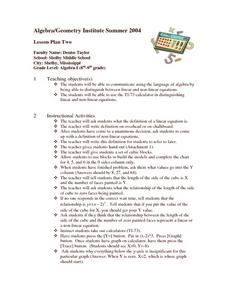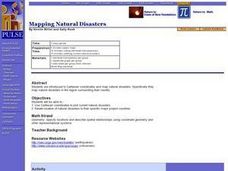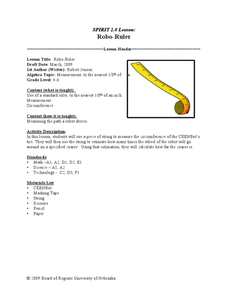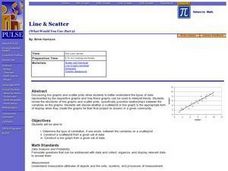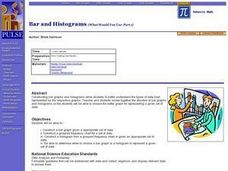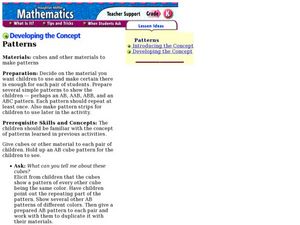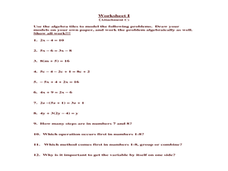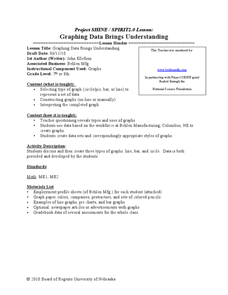Curated OER
Tangrams
Fifth graders explore the context of how and when to use tangrams in geometry. They create and draw a number of different geometric figures using tangrams. Students work on their visual spatial skills.
Curated OER
Linear Functions
Fifth graders investigate the concept of a function in relationship to how it is used. The concept is essential for the future study of Algebra. They apply the use of patterns with its relationship to functions.
Curated OER
Prime and Composite Numbers
Fifth graders investigate the concepts of composite and prime numbers. They factor different numbers and determine the number of factors for each. Based upon this information the number is declared prime or composite.
Curated OER
Linear and Non-Linear Equations
Pupils study linear and non-linear equations. After a teacher demonstration, they use calculators to solve and graph equations. They distinguish the difference between linear and non-linear equations.
Curated OER
Rounding and Estimation
Fifth graders participate in a lesson that is focused on rounding and estimating using word problems. They review how to read word problems, find the right operator, and use the new skills to solve problems.
Curated OER
Mapping Natural Disasters
Students use Cartesian coordinates to plot current natural disasters. They relate location of natural disasters to their specific major project countries. Students tie in geometry within this lesson as connected to spatial relationships...
Curated OER
Pump Up the Volume
Fourth graders calculate volume. In this volume instructional activity, 4th graders calculate, estimate, and compare units of volume in English and metric systems.
Curated OER
Robo Ruler
Students calculate measurements using different units and fractions. In this algebra lesson, students measure the path that a robot drives. They use a piece of sting to do their measurement and calculate the circumference of the robot's...
Curated OER
Spaghetti Bridges
Students thread a piece of spaghetti through the holes in the cup. One person suspend the cup by placing each index finger approximately one inch in from the ends of the spaghetti.
Curated OER
Line & Scatter (What Would You Use: Part 2)
High schoolers discuss line graphs and scatter plots and the best situations in which to use them. Using the graphs, they determine the type of correlation between variables on a scatterplot. They create a scatterplot and line graph...
Curated OER
Animal Tracks
Students are introduced to the topic of area. In groups, they share various techniques to help them identify different shapes and work together to calculate the area. They use this same knowledge to determine the area of animal tracks...
Curated OER
Bar and Histograms (What Would You Use: Part 1)
Students practice creating bar graphs using a given set of data. Using the same data, they create a group frequency chart and histograms. They must decide the best graph for the given set of data. They share their graphs with the...
Curated OER
Shut it Off!
Learners identify the central tendencies. In this statistics lesson, students find the mean, median and mode of their collected data. They explain the effect of outliers on the data.
Curated OER
Spaghetti Bridges
Eighth graders experiment with building bridges of spaghetti, pennies, and a cup to determine how varying the number of spagetti pieces affects the strength of the bridge. They graph their results and interpret the data.
Curated OER
Mathematics in Art?
Fifth graders view prints of M.C. Escher's work. They look at examples of geometric figures and polygons and discuss places they have seen them. Students create their own tessellations. They write a report about the process they used in...
Curated OER
Developing the Concept: Patterns
Students understand what a pattern is and how to make a pattern. In this pattern lesson, students use cubes to create various patterns. Students recognize the pattern created.
Curated OER
Let Algebra Tiles Solve Equations for You
Students practice solving algebra equations utilizing model tiles. In this algebra lesson, students observe a clip from the movie Homeward Bound and break the action down into an algebraic equation. Students solve an algebra...
Curated OER
Fraction Circles
Fourth graders receive a fraction circle and show how each different part makes a whole. Students compare the different fractions that make up a whole. Students choose 2 fractions which are inside a bucket and they compare them both...
Curated OER
Graphing Data Brings Understanding
Young scholars collect, graph and analyze data. In this statistics lesson, students use circle, pie, bar and lines to represent data. They analyze the data and make predictions bases on the scatter plots created.
Curated OER
Probability
Fifth graders study probability of events. They predict outcomes, and participate in hands-on experiments to find the probability of specified events. Afterward, 5th graders write probability of events in fractions and decimals.
Curated OER
What Pie?
Students practice making and interpreting pie graphs so they are better able to decide if a pie chart is the appropriate form of display. Students examine included overheads of different pie charts, and directions on how to make pie...
Curated OER
Geometric Solids
Fourth graders examine the properties of geometric solids. Given geometric figures, they brainstorm observations. In groups, 4th graders identify solids and discuss the physical properties. Each student creates a Venn diagram and...
Curated OER
Prime and Composite Numbers
Sixth graders investigate the concept of prime and composite numbers. They use a review of multiplication to help explain factoring. Students are taught the definition of a prime and composite number and then practice independently.
Curated OER
Order of Operations
Seventh graders practice using the Order of Operations to simplify algebraic expressions. They start with some basic operations and move into gradual harder problems to bring to the level of mastery.





